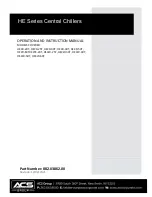
34
CVHE-SVX005B-EN
N
No
otte
ess::
•
Some type of field-supplied temperature
control device may be required to regulate
the temperature of the heat-recovery
condenser water circuit. For application
recommendations, refer to
Heat Recovery
Seminar (Part 2): Systems/Equipment
(AM-
FND-8).
•
Install a bypass valve system to avoid
circulating water through the auxiliary shell
when the unit is shut down.
•
On multiple-pass condensers, entering
condenser water must enter at the lowest
nozzle.
Piping must be arranged and supported to avoid stress
on the equipment. It is strongly recommended that the
piping contractor does not run pipe closer than 3 ft
(0.9 m) minimum to the equipment. This will allow for
proper fit upon arrival of the unit at the job site. Any
adjustment that is necessary can be made to the piping
at that time. Expenses that result from a failure to
follow this recommendation will NOT be paid by Trane.
Water piping connection sizes and components are
identified in the tables in
and
. Remember that with many waterboxes, the
entering and leaving evaporator water can be piped to
either waterbox connection when the tube bundles are
split vertically. However, large evaporator waterboxes
with entering and leaving connections not at the same
level must be connected with the entering water at the
bottom and the leaving water at the top.
Waterboxes with multiple pass arrangements utilize a
baffle to separate the passes. These baffles are
designed for a maximum pressure of 20 psid
(137.9 kPaD). If larger pressure drops are expected in
the application, contact your local Trane representative
to discuss special waterbox options.
IIm
mp
po
orrtta
an
ntt:: Water flows must be piped in accordance
with nameplate designation.
Field-provided isolation valves for the evaporator and
condenser water lines should be installed upstream
and downstream of the heat exchangers, and be
installed far enough away from the chiller to also
provide practical service isolation for flow sensing
devices, field thermometers, flexible connectors, and
any removable pipe spools.
Ensure that the evaporator water piping is clear; check
it after the chilled water pump is operated but before
initial chiller start-up. If any partial blockages exist, they
can be detected and removed to prevent possible tube
damage resulting from evaporator freeze-up or
erosion.
For condenser and large evaporator connections,
arrange the water piping so that the water supply
enters the shell at the lower connection and exits from
the top connection. Operational problems may result if
this piping is not correct. Some shells may be piped as
desired since both connections are at the same level.
For applications that include an “infinite source” or
“multiple-use” cooling condenser water supply, install
a valved bypass “leg” (optional) between the supply
and return pipes. This valved bypass allows the
operator to short-circuit water flow through the cooling
condenser when the supply water temperature is too
low. For additional application information, refer to
Engineering Bulletin: Condenser Water Temperature
Control - For CenTraVac Centrifugal Chiller Systems
with Tracer AdaptiView Controls
(CTV-PRB006*-EN).
N
No
otte
ess::
•
System refrigerant pressure differential
must be maintained above 3 psid
(20.7 kPaD) at all times. Failure to do so
could result in operating problems.
•
Whenever a CVHE, CVHF, or CVHG
CenTraVac
™
chiller is equipped with an
auxiliary condenser, use a bypass valve
system to avoid circulating water through
the auxiliary shell during unit shut-down.
Water Piping Connections
All standard units use grooved-pipe connections.
These are grooved-end NSP (Victaulic
®
style) pipe
connections. Flanged connections are optional.
Piping joined using grooved type couplings, like all
types of piping systems, requires proper support to
carry the weight of pipes and equipment. The support
methods used must eliminate undue stresses on joints,
piping, and other components, allow movement where
required, and provide for any other special
requirements (i.e., drainage, etc.).
N
No
otte
e:: If needed, plug-type sensor extension cables are
available for purchase from Trane Parts Service.
These sensor extension cables may be necessary
if the waterboxes are changed or if the
temperature sensors are moved out into the unit
piping for better mixed temperature readings.
Table 6. Evaporator water piping connection sizes
EVSZ
(a)
Nominal Pipe Size
1-Pass
2-Pass
3-Pass
in.
mm
in.
mm
in.
mm
032
8
219.1
6
168.3
5
141.3
050
10
273.0
8
219.1
6
168.3
080
12
323.9
10
273.0
8
219.1
142
16
406.4
12
323.9
10
273.0
210
16
406.4
14
355.6
12
323.9
250
16
406.4
14
355.6
12
323.9
(a)
EVSZ = Evaporator Shell Size; S = Short Shell, L = Long Shell, E =
Extended Shell
















































